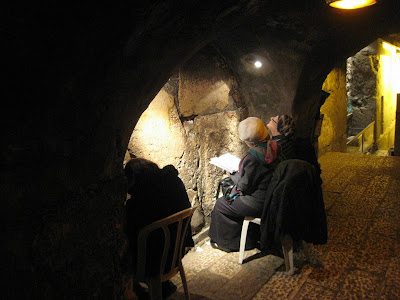Jerusalem - the heart of Christinity, the spiritual center of Judaism, and a focal point for Islamic prayer as the place from which Mohammed ascended to heaven. I knew intellectually that these three religions intersected, co-existed and conflicted over the 1 square mile of Jerusalem, but it really does take walking the streets to make the reality of the situation sink in. I thought I would write about a few experiences that Sarah and I had that brough this reality home for us.
While the ownership of the land that is central to one’s religion is the issue over which wars have been fought for thousands of years, it was moving and fascinating to see what that actually means to the people on the ground. Not the locals, but those that come on pilgramiges from all over the world to connect with the spiritual center of their religion. They come to lay their hands on the Western Wall, which is the last remaining wall of the Second Temple, they come to pray at the Temple of the Mount or the Al-Aqsa Mosque, or they come to lay their hands on the stone on which Jesus was lain after his cruxification.
The first of these sites on our list was the Western Wall. The current site is only a tiny portion of the original wall, but we were lucky enough to be able to take a tour along the excavation that runs between the current houses of Jerusalem and the original stones that King Herod’s workers laid thousands of years ago. The tour comes to a spot only a hundred yards or so from the Holy of Holies, the geographical center of the Jewish religion. Here, there were a few people sitting in chairs, lost in deep prayer.
The second of the sites for us was the Church of the Holy Selphurcure, which contains a number of relics holy to the Christian faith. Upon entering the church you come across the stone where Jesus was laid to be anointed with oils after his cruxification. People come thousands of miles to lay their hands on this rock (or in some cases bags full of scarves to take back home). There is also part of the pillar that Jesus leaned up against when he fell and the rock that supposedly was where Jesus’s cross was erected.
And finally the Dome of the Rock and the Al-Aqsa Mosque, both of which we had to view from a distance. In each of these cases, people are performing a similar ritual. In their own way, they are paying their respects to a power higher than their own, whether it be through prayer, kneeling, or prostration on the ground. The similarlity between these actions stuck me as saying something profound about what we as humans find in our religious customs. They are humbling, they connect us with a force larger and more profound that we can even conceptualize, large enough that it can symbolize an entire ethos or the ideal way to comport one’s self in the world.
For instance, upon leaving the Western Wall tunnel, we emerged in the Muslim quarter of the Old City, on the length of the Via Dolorosa where Jesus was sentenced to death. On that corner, at the edge of the Western Wall, we stood with our tour guide Ami amid the Muslim shops and contemplated that critical moment for Christianity. Then Ami brought us to a Muslim restaurant a few doors down where he spoke a few friendly words in Arabic with the owner and had a feast brought out.
This overlap sadly is fraught with issues. There are constant reminders of the threat of violence that clouds over life in Jerusalem. Each Israeli boy and girl is required to do two years in the military upon graduating from high school, which results in a bunch of kids that look like they are on spring break but are in uniform, which includes a massive rifle. They are a constant presence by numbers all over the city. I can’t imagine someone trusting me with a huge gun and lots of responsibility when I was 18, I found working in a sandwich shop challenging enough, but here these kids are, learning a lesson about protecting their country at a very early age.
And finally, like any city, Jerusalem is a living breathing entity with as many funny quirks as they are sobering or scary moments.
A coke can for example, tells a lot about the area of town where you are having lunch.
Tchotchke dealers are the same the world over. Always ready to turn a sporting fervour into a profitable business. (Go Sox!)
Purim, the Jewish version of Halloween, really brings out the best of a city.











No comments:
Post a Comment